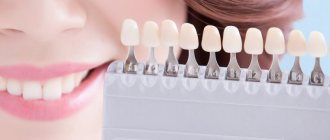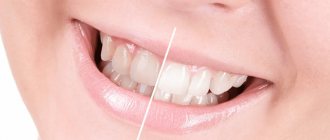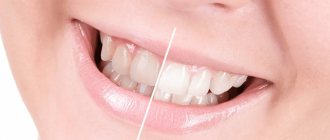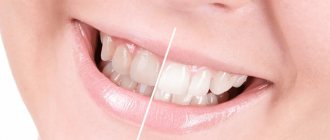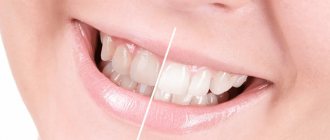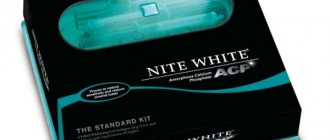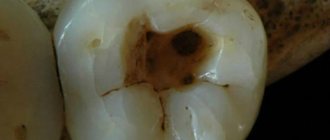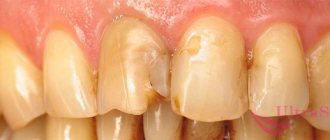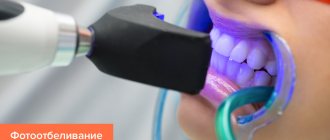Indications Is bleaching harmful?
Why do teeth darken? Whitening methods Safety of home whitening Whitening in dentistry Stages Care A snow-white smile is the dream of every person. And everyone is interested in safe teeth whitening. Many people have heard about bad experiences from friends and the Internet and are afraid to repeat these mistakes. But the procedure has been well studied, but it is important to know which Moscow clinic can provide truly high-quality and gentle teeth whitening.
Is whitening safe?
What is teeth whitening? This is a cosmetic procedure in which the color of dentin changes (namely, the color of the tooth depends on it) - lightening by several tones under the influence of active substances. Whether it is safe or not depends on the professionalism of the dentist, as well as on the technologies and drugs that are used for these purposes (these must be registered drugs, modern methods). If we are talking about whitening at home, everything is the same, only instead of a doctor, it is the rationality of a person.
ROOTT Clinic expert on the most important things when whitening
In general, whitening is a fairly safe procedure if the teeth have good mineralized enamel, healthy gums and good oral hygiene.
How does the product work?
As has already been found out, soda is used to clean teeth and eliminate gum disease and caries.
For your information! It has been scientifically proven that products containing 30-60% baking soda can remove plaque.
Sodium bicarbonate is thought to increase the pH in the mouth, which counteracts the harmful effects of bacterial metabolic acids.
Sodium bicarbonate effectively removes plaque and acts as a polishing agent. But teeth can still react sharply to soda . For example, this happens if a person has thin or damaged enamel. The product begins to increase tooth sensitivity, the enamel becomes thinner.
Indications and contraindications
Most often, the patient prescribes the indication for whitening to himself - he is not satisfied with the aesthetic appearance of especially the front teeth, which are visible when smiling. I want it to be whiter and more dazzling.
Darkening of the enamel can also occur due to frequent intake of coffee, cigarettes, dark berries and even medications.
But there are also a number of contraindications
:
- pregnancy and lactation;
- age under 18 years;
- allergies to drugs;
- the presence of fillings, crowns, veneers (they simply do not whiten);
- bracket systems, staples;
- cancer;
- hypersensitivity;
- active caries, periodontitis or other oral diseases;
- wedge-shaped defect (dentin exposed);
- rapid abrasion of enamel;
- in some cases diabetes mellitus.
You should definitely consult with your doctor about indications and contraindications so that together you can choose a safe method for teeth whitening. And of course, carry out a complete sanitation of the oral cavity to avoid uneven color after the procedure.
Before-after photos of teeth whitening at the ROOTT clinic
Types of rinsing solutions
- Soda. Sodium bicarbonate has a good antifungal effect, soda is effective as a prophylaxis against gum inflammation. It is recommended to add a teaspoon of the chemical element to a glass of warm boiled water. The advantages of the solution include the fact that it gently cleanses the oral cavity and tooth enamel and has a good disinfectant effect.
- Salt. Saline solution is a good antiseptic. To prepare, dilute a spoonful of salt in a glass of warm water. Salt promotes rapid healing of cracks and wounds, soothes the diseased element of the dental system.
- Soda-salt. The use of soda-salt solution is the most effective therapeutic and preventive method. In this case, mix a teaspoon of soda and salt in a glass of warm water. The best option when the first symptoms of various dental pathologies appear.
- Soda-salt with iodine. An indispensable assistant in solving various dental problems. It is necessary to rinse your mouth with iodine, salt and soda in the right proportions. Half a teaspoon of soda and salt and a drop of iodine are diluted in warm water. Everything is thoroughly mixed. It is used as a prophylaxis for bleeding gums and for the treatment of all kinds of inflammatory processes.
We looked at how you can make soda-salt baths using various additional components. Today there is a wide variety of solutions, but it is necessary to consult a specialist. Following the doctor’s recommendations will help prevent drying of the mucous membrane, increased sensitivity of the enamel and other negative phenomena.
What harm can bleaching cause?
The safest teeth whitening will be under the supervision of a professional dentist. Indeed, with inept management and the wrong approach, a number of troubles can arise:
- Negative effects on tooth enamel of incorrectly selected concentrations of bleaching agents. This is both increased sensitivity and an increase in the microporosity of its structure. Over time, the ingestion and accumulation of food dyes may cause the tooth color to become even darker than before;
- chemical burn of gum tissue due to improper isolation;
- uneven lighting.
What whitening methods are there?
The dentist will advise which teeth whitening is safe for each patient individually. But everything that takes place under the supervision of a doctor will definitely not harm - there is no doubt about it, especially when using the latest technologies, delicate compounds and modern developments.
Professional teeth whitening methods:
- Photobleaching;
- laser whitening;
- whitening gel only;
- hardware method.
The first two methods use a lamp or laser as a catalyst for the action of the whitening gel.
Photobleaching, for example, ZOOM, enhances the effect of active hydrogen peroxide, helping to quickly break it down into free radicals - oxygen atoms. of up to 10 tones occurs.
. With proper care, the results last for several years.
The laser procedure differs in that instead of a light beam, a laser beam acts. It can heat the surface, which causes sensitivity (everything is in the hands of a professional doctor, since the advantage of a laser is accuracy), and copes well with changing color by 10-12 tones
and maintaining it for up to 5 years. The downside is the high cost of the method.
Dentists are still arguing about what is the safest teeth whitening, and whether laser and light are necessary for the best results. But it has been proven that the method of applying gel without using them is also effective. Opalescence technology with 40% hydrogen peroxide in the gel is cheaper in price and has proven itself in aesthetic dentistry.
A simple dental cleaning at the clinic is often sufficient for many people. After removing stones and plaque, the teeth become several shades lighter. Using one of these methods:
- Air-Flow hardware cleaning (the principle is similar to a sandblasting machine, but instead of sand, soda);
- ultrasound.
You can be satisfied with the result of your renewed smile.
Reviews
Below are some reviews. If you have something to say, leave your feedback in the comments below the article, it will be useful to our readers.
Sergey, 45 years old, Samara . At a certain point, plaque began to bother me, and later caries. I went to the clinic, the doctor suggested an expensive paste and ultrasonic cleaning. I decided to try baking soda. The effect did not appear immediately, but after 5 applications the plaque began to gradually disappear, and the bad breath disappeared.
Tatyana, 27 years old, Yemanzhelinsk . I am a lover of strong coffee, so I have been drinking it all my life. I noticed that my teeth were getting darker and started looking for teeth whitening products. While on the form, I came across an article that talked about brushing your teeth with soda. I decided to try it. I cleaned it once a week so as not to damage the enamel. I was pleased with the result.
Is it possible to whiten teeth safely at home?
The market offers more and more varieties of home whitening methods, whether they are safe or not - everything is individual. And the course usually lasts 10-20 days. However, not everyone is of any use.
Manufacturers offer:
- Whitening strips;
- mouth guards with active composition;
- felt-tip pens, markers;
- toothpastes with whitening effect.
All products contain the same hydrogen peroxide, but in a much lower concentration. Therefore, it will be possible to lighten and visually change the color of the enamel by 1-2 tones.
Rather, this is a lightening procedure, that is, you can safely bleach if you agree to change the shade by just a couple of tones, and are willing to spend a lot of time for a relatively small result.
But using professional products at home is not recommended. Is it dangerous.
Rules of application
To achieve white teeth without damaging the enamel layer of the tooth, you need to use sodium bicarbonate a maximum of once a month. In this case, you need to use it mixed with water, the consistency should be mushy. You can use any other solvent.
Attention! Do not use dry soda under any circumstances; it can leave scratches on the enamel layer.
This is what the paste should look like
In addition, dry soda powder feels like sand in the mouth, which causes discomfort. It is better to use the product in diluted form, mixing it with toothpaste or other substance.
There are several proven recipes for preparing homemade soda pastes and solutions, which will be discussed below.
The method of brushing your teeth can be standard, but it is better to use circular movements of the brush. This will not only clean the tooth surfaces, but also massage the gums, improving tissue trophism.
Safe whitening steps
- It is necessary
to carry out professional oral hygiene a few days - Isolation of soft
gum tissue. If you isolate the gum incorrectly, the patient will receive a severe burn, which will lead to complications. Therefore, safe teeth whitening in dentistry should only be carried out by an experienced doctor specializing in this field. - A special gel
based on hydrogen peroxide is applied. It is updated every 15 minutes: it is removed from the surface of the teeth (as it develops its properties) and a new portion is applied. The gel is changed three times. - Activation of the gel using a special lamp
. The dentist places a special lamp, the light of which will activate the gel. It is necessary to speed up the procedure and reduce it to 1 hour. The lamp has a cold LED light that does not heat the enamel structure and the procedure is comfortable for the patient. - Removing gel
from the enamel surface and all insulating materials from the gum surface. - Procedure for strengthening teeth
. A gel is applied that strengthens tooth enamel and reduces sensitivity.
Whitening is carried out in the smile zone, from 5 to 5 teeth of the lower and upper jaw. The procedure takes on average 1 hour
. Anesthesia is not given. This is necessary so that there is direct contact between the patient and the doctor, and the former can report if discomfort or pain occurs. Otherwise, you may miss the moment when something went wrong: a burn to the mucous membrane, too aggressive exposure to the material, a person’s low pain threshold.

